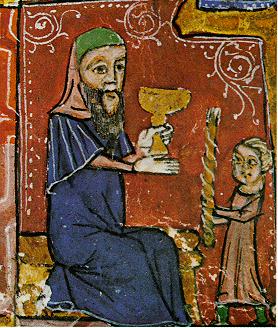Time-keeping is a tricky business because neither years nor months are evenly dividable by days. There are approximately 365.2492 days in a solar year. The lunar month varies from 29.26 to 29.80 days. Therefore, it is mathematically impossible to group earth days into years that correspond exactly to the solar and lunar periods. Twelve lunar months, each averaging 29.5 days, gives a year of 354 days, about 11 days less than the average length of the solar year.
Certain early forms of ancient Judaism (like the form at Qumran) insisted on a strict solar calendar of 52 weeks for a total of 364 days. No intercalary days were allowed. This system meant that the annual holidays always fell on the same day every year. Each year, this calendar would drift about 1.25 days further away from the actual solar year.
The traditional Jewish calendar is a lunisolar calendar.
"lunar" = each month begins on the New Moon.
"solar" = periodically an additional month is added to
keep the lunar calendar synchronized with the solar year.
This month is called an intercalary month.
The Babylonians discovered that by inserting seven intercalary months in a 19-year period they could keep the lunar months from drifting away from the solar year. The Jews adopted this handy lunisolar system; it is attributed to Hillel II (around 358 or 361 CE). And, the late books of the Tanakh had already begun the practice of using Babylonian names for the months.
This (spring of 2013) is 5773 A.M.
In the traditional Jewish dating system, years are dated from the traditional date for the creation of the world and are identified Anno Mundi ("in the year of the world") or Year of Creation.
October 7, 3761 BCE = the first day of creation.
So from Rosh Ha-Shannah (Tishri 1) to December 31,
the Hebrew year = the Gregorian year + 3761.
From January 1 to the last day of the Hebrew year,
the Hebrew year = the Gregorian year + 3760.
For example, February of 2012 C.E. is 5772 A.M. (2012 CE + 3760 = 5772 AM).
In ordinary usage, the Hebrew year is abbreviated, with the understanding that an additional 5000 is implied. For example, the year 5772 is actually written 772 in Hebrew, like this, תשע״ב, that is, bet '' ayin shin tav (2 + 70 + 300 + 400 = 772).
So, the easiest way to get the Gregorian year is to take the abbreviated Hebrew year and add 1240 to it. If the date is in the early part of the Jewish year (Tishri 1 to December 31), take away 1 year. For example, 772 + 1240 = 2012 CE.
Typically, the calendar of a religious tradition gives a rhythm to the life of its adherents. And so it is with Judaism.
The main holidays of the Jewish year include: Rosh Hashannah (the New Year), Sukkot (Festival of Booths), Chanukkah (Festival of Lights), Purim, Pesach (Passover and the Festival of Unleavened Bread), and Shavuot (Pentecost or Festival of Weeks). Simchat Torah (Joy of the Law) and Shemini Atzeret (the eighth day of Sukkot) are particularly joyous festivals. Yom Kippur is the most important fast and it introduces the High Holy Days that culminate in Rosh Hashannah.
Every day has its times of prayer for the observant Jew: morning and evening prayer.

Without doubt, the basic rhythm of the Jewish year is set by the weekly observation of Shabbat, the seventh day of the week. In traditional families, there is a pronounced demarcation as one moves into the sacred time of Shabbat, and then again as one moves back into the ordinary time of the rest of the week (see 14th-century picture of Havdala at left).
It should be noted that the Jewish day begins at sunset. So Shabbat begins at sundown Friday evening and lasts until sundown Saturday evening. Similarly, the festivals and fasts of Judaism all begin at sundown the evening before they are marked on the calendar.
Christendom adopted the Julian calendar of the Roman Empire, a solar calendar. However, the date of Easter is determined by lunar calculations similar to to those used for determining the date of the Jewish Passover (of which Easter is an adaptation). In 1528, the Catholic West accepted the Gregorian calendar (as a correction to the Julian calendar, which by then was ten days out of sync with the sun), but the Orthodox East continues to use the Julian calendar. So East and West often celebrate Easter on different days.
Liturgical churches follow an annual liturgical calendar that has developed over many centuries (see example). The seasons of this calendar are as follows:
The "Anno Domini" dating system was developed by Dionysius Exiguus, but the Venerable Bede was the first person to use it extensively. There is no year 0 in this system.
Islam follows a strictly lunar calendar (see Qur'an 9:36-37). It is never adjusted to coordinate with the solar year. So it falls behind the Gregorian solar calendar about 10.25 days each year. This is why the month of Ramadan and the month of the Hajj gradually move through different seasons as the years progress. The months of the Islamic year are as follows:
Usually, the Islamic year is 354 days long. Odd-numbered months of the year have 29 days, even-numbered months have 30 days. This doesn't quite match the lunar cycle, and so eleven times in a thirty-year period, an intercalary day is added to the last month to keep aligned with the lunar year.
The "Anno Hegirae" dating system counts 622 C.E. as 1 A.H. Again, there is no year 0. Because the years are shorter than the solar year, using a table is the easiest way to convert from A.H. to C.E. and back.
(For more information, see these websites: A Brief Introduction to the Islamic Calendar and Gregorian-Hijri Date Converter.)